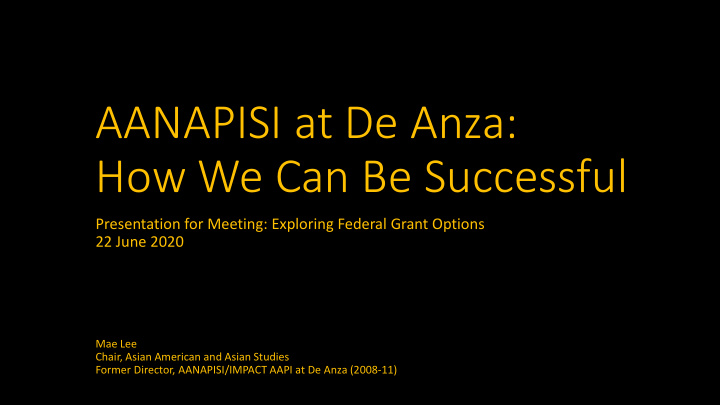



AANAPISI at De Anza: How We Can Be Successful Presentation for Meeting: Exploring Federal Grant Options 22 June 2020 Mae Lee Chair, Asian American and Asian Studies Former Director, AANAPISI/IMPACT AAPI at De Anza (2008-11)
Ove verview 1. Institutional Memory = Faculty and Staff Involvement 2. Purpose of the AANAPISI federal grant program 3. Origins of IMPACT AAPI: AANAPISI 2008-11 and 2011-17 4. Goals: 2008-2011 and 2011-2017 5. How Can We Be Successful: Lessons Learned
1. Institutional M Memory Faculty and classified professionals involved with AANAPISI from 2008-2017.
2. Purpose o e of A AANA NAPISI Gr Grant Progr ogram Strengthening AANAPISI grants awarded under Title III-A and Title III-F must be used to assist an institution in planning, developing, and implementing activities that improve and expand the institution’s capacity to serve Asian American and Native American Pacific Islander students. (Federal Register / Vol. 85, No. 18 / Tuesday, January 28, 2020) Q: In what way do we want to expand De Anza’s capacity as an institution to serve AAPI students?
3. 3. Or Origins: s: A AANAPISI Gran ant P Proposal sals 2008 2011 2016 Grant Terms • two-year grant (extended • five-year grant (extended • five-year grant a third year) a sixth year) • $1.5 million • $1.25 million • $2.0 million AWARDED AWARDED NOT AWARDED Proposal • written by Asian American • written by Asian American • hired grant-writer with Writing Studies faculty, release Studies faculty college input funded by APALI • meetings with key • focus groups with key partners and stakeholders stakeholders collaborated with • • collaborated with Institutional Research for Institutional Research for disaggregated data disaggregated data *Full proposal available on ASAM *Full proposal available on ASAM webpage “IMPACT AAPI” webpage “IMPACT AAPI”
4. Goal als f s for AANAPISI 2008 2008-201 2011 Title: Targeted Support for AANAPI Student Preparedness and Achievement Data-Informed and Vision-Based Goals: 1) increase student access to college services for AANAPI students from lower-income geographic areas and families; 2) improve overall student persistence among first-time De Anza students who plan to transfer/obtain a degree or are undecided; 3) improve student readiness for college-level courses among first-time De Anza students who enter the college at pre-collegiate course levels; and 4) improve the overall course success rate of AANAPI subgroups with rates below the college average.
4. Goal als f s for AANAPISI 2011 2011-201 2017 Title: Closing the Achievement Gap Among Asian American and Pacific Islander Students Data-Informed and Vision-Based Goals: 1. improve transfer pathways for AANAPISI subgroups from lower income geographic areas and families; 2. improve student readiness for college-level courses among first-time De Anza students who enter the college at pre-collegiate course levels in English and Math; and 3. increase AANAPISI student access to STEM majors and fields among AANAPISI subgroups
5. Le Lessons Le Learned f from 2008-2017 017 1. To deconstruct and displace stereotypes of AAPIs as “model students,” “narrowly academic,” and “un-deserving minorities” situate AAPIs in national discourse of race and education through public reframing that centers need for institutional change Ex: Pres. Murphy speaking nationally and locally about significance of AANAPISIs in tandem with De Anza values Ex: reframe hierarchy of student needs (zero-sum mindset) vs. high-impact leverage points to undo institutional problems such as interlocked racisms (e.g., address teacher expectations across racial groups since teacher biases of different groups are mutually linked)
5. Le Lessons Le Learned f from 2008-2017 017 (cont’d 1 d 1) 2. For quicker upstart and efficient use of resources build on existing program infrastructure of college Ex: Asian American Studies, LinC, MPS, Office of Prof. Devt, SSRS, FYE, New Student and Parent College Night 3. For sustainable work and integrity of program focus value and compensate dedicated labor or hire as needed Ex: release and stipends for faculty, hiring of tenure-track counselors, etc.
5. Le Lessons Le Learned f from 2008-2017 017 (cont’d 2 d 2) 4. To address institutionalized racism and invisibility of AAPIs in college curriculum integrate Asian American Studies/Ethnic Studies (aka culturally relevant pedagogy) and dedicated counselors Ex: LCs that center Asian American Studies, FT counselors 5. For long-term capacity-building of institution articulate a college vision for serving needs of AAPI students beyond period of grant funding Ex: What is the intention and strategic plan of the college for addressing AAPI student needs after the grant?
Recommend
More recommend